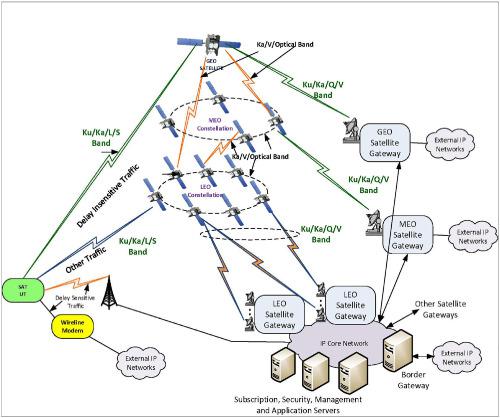当前位置:
X-MOL 学术
›
Int. J. Satell. Commun. Netw.
›
论文详情
Our official English website, www.x-mol.net, welcomes your
feedback! (Note: you will need to create a separate account there.)
Next‐generation global satellite system with mega‐constellations
International Journal of Satellite Communications and Networking ( IF 0.9 ) Pub Date : 2020-07-24 , DOI: 10.1002/sat.1351 Channasandra Ravishankar 1 , Rajeev Gopal 1 , Nassir BenAmmar 1 , Gaguk Zakaria 1 , Xiaoling Huang 1
International Journal of Satellite Communications and Networking ( IF 0.9 ) Pub Date : 2020-07-24 , DOI: 10.1002/sat.1351 Channasandra Ravishankar 1 , Rajeev Gopal 1 , Nassir BenAmmar 1 , Gaguk Zakaria 1 , Xiaoling Huang 1
Affiliation

|
Mega satellite constellations in low earth orbit (LEO) will provide complete global coverage; rapidly enhance overall capacity, even for unserved areas; and improve the quality of service (QoS) possible with lower signal propagation delays. Complemented by medium earth orbit (MEO) and geostationary earth orbit (GEO) satellites and terrestrial network components under a hybrid communications architecture, these constellations will enable universal 5G service across the world while supporting diverse 5G use cases. With an unobstructed line‐of‐sight visibility of approximately 3 min, a typical LEO satellite requires efficient user terminal (UT), satellite, gateway, and intersatellite link handovers. A comprehensive mobility design for mega‐constellations involves cost‐effective space and ground phased‐array antennas for responsive and seamless tracking. An end‐to‐end multilayer protocol architecture spanning space and terrestrial technologies can be used to analyze and ensure QoS and mobility. A scalable routing and traffic engineering design based on software‐defined networking adequately handles continuous variability in network topology, differentiated user demands, and traffic transport in both temporal and spatial dimensions. The space‐based networks involving mega‐constellations will be better integrated with their terrestrial counterparts by fully leveraging the multilayer 5G framework, which is the foundational feature of our hybrid architecture.
中文翻译:

具有巨型星座的下一代全球卫星系统
低地球轨道(LEO)中的巨型卫星星座将提供完整的全球覆盖;迅速提高整体能力,即使在没有服务的地区也是如此;并以较低的信号传播延迟提高服务质量(QoS)。这些星座由混合通信架构下的中地球轨道(MEO)和地球静止地球轨道(GEO)卫星以及地面网络组成部分组成,这些星座将在支持各种5G用例的同时,在全球范围内实现通用5G服务。典型的LEO卫星在大约3分钟的无障碍视线范围内,需要高效的用户终端(UT),卫星,网关和星际链路切换。大型星座的综合移动性设计涉及具有成本效益的空间和地面相控阵天线,以进行响应和无缝跟踪。跨空间和地面技术的端到端多层协议体系结构可用于分析和确保QoS和移动性。基于软件定义网络的可扩展路由和流量工程设计可以充分应对网络拓扑结构的不断变化,差异化的用户需求以及时空维度上的流量传输。通过充分利用多层5G框架,涉及大型星座的空基网络将更好地与地面对应网络集成,这是我们混合架构的基本特征。跨空间和地面技术的端到端多层协议体系结构可用于分析和确保QoS和移动性。基于软件定义网络的可扩展路由和流量工程设计可以充分应对网络拓扑结构的不断变化,不同的用户需求以及时空维度上的流量传输。通过充分利用多层5G框架,涉及大型星座的空基网络将更好地与地面对应网络集成,这是我们混合架构的基本特征。跨空间和地面技术的端到端多层协议体系结构可用于分析和确保QoS和移动性。基于软件定义网络的可扩展路由和流量工程设计可以充分应对网络拓扑结构的不断变化,不同的用户需求以及时空维度上的流量传输。通过充分利用多层5G框架,涉及大型星座的空基网络将更好地与地面对应网络集成,这是我们混合架构的基本特征。和交通运输在时间和空间方面。通过充分利用多层5G框架,涉及大型星座的空基网络将更好地与地面对应网络集成,这是我们混合架构的基本特征。和交通运输在时间和空间方面。通过充分利用多层5G框架,涉及大型星座的空基网络将更好地与地面对应网络集成,这是我们混合架构的基本特征。
更新日期:2020-07-24
中文翻译:

具有巨型星座的下一代全球卫星系统
低地球轨道(LEO)中的巨型卫星星座将提供完整的全球覆盖;迅速提高整体能力,即使在没有服务的地区也是如此;并以较低的信号传播延迟提高服务质量(QoS)。这些星座由混合通信架构下的中地球轨道(MEO)和地球静止地球轨道(GEO)卫星以及地面网络组成部分组成,这些星座将在支持各种5G用例的同时,在全球范围内实现通用5G服务。典型的LEO卫星在大约3分钟的无障碍视线范围内,需要高效的用户终端(UT),卫星,网关和星际链路切换。大型星座的综合移动性设计涉及具有成本效益的空间和地面相控阵天线,以进行响应和无缝跟踪。跨空间和地面技术的端到端多层协议体系结构可用于分析和确保QoS和移动性。基于软件定义网络的可扩展路由和流量工程设计可以充分应对网络拓扑结构的不断变化,差异化的用户需求以及时空维度上的流量传输。通过充分利用多层5G框架,涉及大型星座的空基网络将更好地与地面对应网络集成,这是我们混合架构的基本特征。跨空间和地面技术的端到端多层协议体系结构可用于分析和确保QoS和移动性。基于软件定义网络的可扩展路由和流量工程设计可以充分应对网络拓扑结构的不断变化,不同的用户需求以及时空维度上的流量传输。通过充分利用多层5G框架,涉及大型星座的空基网络将更好地与地面对应网络集成,这是我们混合架构的基本特征。跨空间和地面技术的端到端多层协议体系结构可用于分析和确保QoS和移动性。基于软件定义网络的可扩展路由和流量工程设计可以充分应对网络拓扑结构的不断变化,不同的用户需求以及时空维度上的流量传输。通过充分利用多层5G框架,涉及大型星座的空基网络将更好地与地面对应网络集成,这是我们混合架构的基本特征。和交通运输在时间和空间方面。通过充分利用多层5G框架,涉及大型星座的空基网络将更好地与地面对应网络集成,这是我们混合架构的基本特征。和交通运输在时间和空间方面。通过充分利用多层5G框架,涉及大型星座的空基网络将更好地与地面对应网络集成,这是我们混合架构的基本特征。











































 京公网安备 11010802027423号
京公网安备 11010802027423号